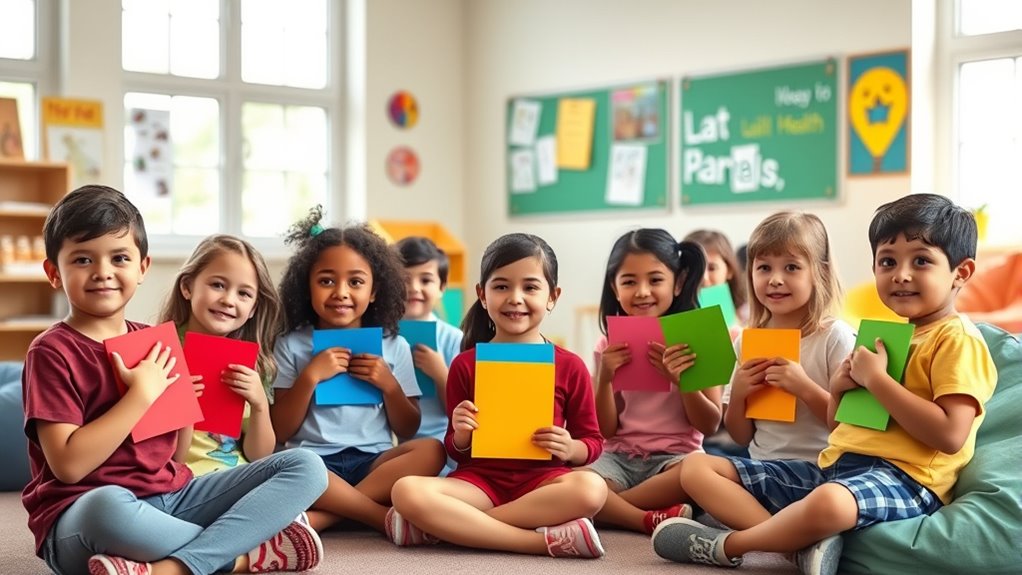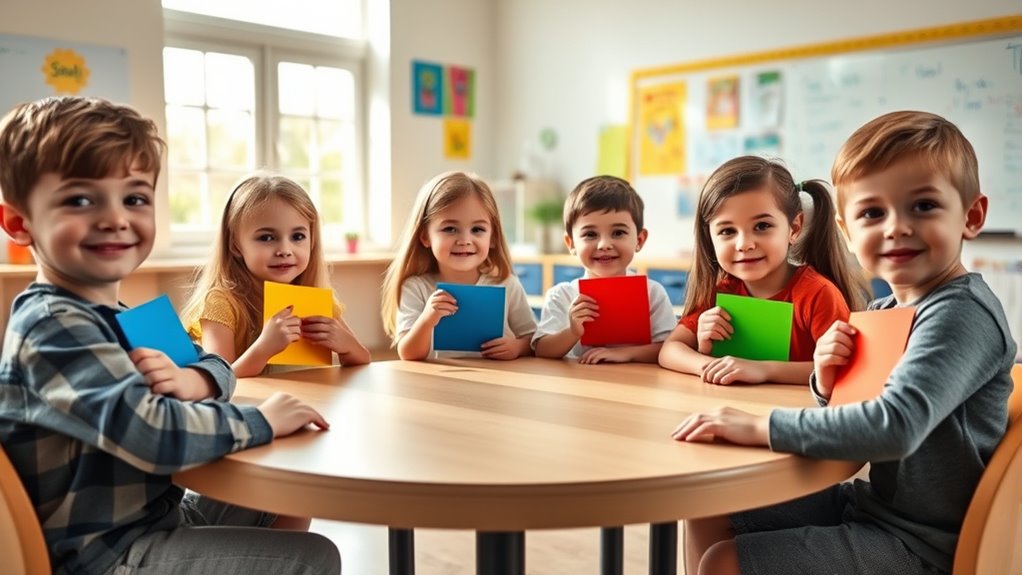Using a color-coded system for mental health check-ins makes it easy for kids to recognize and share their feelings. By associating colors like red for anger, blue for sadness, yellow for happiness, and green for contentment, children can quickly identify their emotions without complicated words. Incorporating these simple cues into daily routines encourages self-awareness and early problem-solving. If you keep exploring, you’ll discover more ways to help kids manage their emotions effectively.
Key Takeaways
- The color-coded system uses simple visual cues like red, blue, yellow, and green to help kids identify and communicate their emotions easily.
- It encourages regular mental health check-ins by associating feelings with colors during daily routines, making self-awareness accessible and routine.
- Kids learn to associate specific emotions—such as anger, sadness, happiness, or contentment—with colors, enhancing emotional vocabulary.
- The system reduces confusion about feelings and supports early recognition of emotional shifts, promoting healthier mental habits.
- Incorporating quick questions like “What color are you today?” helps children reflect on their mood in a simple, understandable way.

Have you ever wondered how checking in on your mental health can make a difference in your daily life? It might seem simple, but taking a moment to pause and reflect can have a profound impact on your overall well-being. One effective way to do this is by using a color-coded system that kids can easily understand. This method helps you tune into your emotions and communicate how you’re feeling without needing complex words or explanations. It’s a straightforward approach that fits seamlessly into your daily routines, making mental health check-ins feel natural rather than burdensome.
When you start incorporating this color system, you’ll find that developing a strong emotional vocabulary becomes easier. Colors serve as visual cues that connect to specific feelings, so you don’t need to come up with elaborate descriptions each time. For example, red might signify anger or frustration, blue could indicate sadness or calmness, yellow might stand for happiness or energy, and green could represent contentment or neutrality. By associating these colors with your emotions, you create a simple, accessible language that helps you recognize and express what you’re experiencing. This clarity can reduce confusion and prevent small issues from escalating into bigger problems because you’re more aware of your emotional state throughout the day.
Incorporating this into your daily routines encourages consistent self-awareness without feeling like a chore. You might start your morning by asking yourself, “What color best represents how I feel today?” or end your day with a quick check-in, noting your dominant color. Over time, you’ll become more attuned to shifts in your mood and energy levels, making it easier to address concerns early on. These check-ins can be brief, fitting naturally into your existing habits—whether you’re brushing your teeth, commuting, or winding down before bed. The key is consistency, which helps you build a habit of regular emotional check-ins. Additionally, practicing stillness can enhance your ability to notice subtle emotional changes and foster greater self-awareness.
Frequently Asked Questions
How Can Parents Introduce the Color-Coded System to Reluctant Children?
When introducing the color-coded system to reluctant children, focus on trust-building strategies by explaining how it helps them express feelings safely. Use visual aids like colorful charts or stickers to make the system engaging and easy to understand. Encourage your child to participate in choosing colors and discussing what each one represents. This involvement fosters trust and makes them more willing to embrace the system, creating a supportive environment for emotional sharing.
What if a Child’s Feelings Don’t Fit Neatly Into a Color Category?
Sometimes your child’s feelings are like a beautiful, complex painting—full of emotional nuance that doesn’t fit into simple categories. When their emotions don’t align with a specific color, reassure them that feelings are layered and unique. Encourage open dialogue, validate their experience, and remind them that it’s okay to feel a mix of emotions. This approach helps them understand that their complex feelings are valid, even if they don’t fit a preset box.
How Often Should Mental Health Check-Ins Be Conducted in School Settings?
You should conduct regular mental health check-ins, ideally weekly or biweekly, to guarantee accurate frequency assessment and support emotional literacy. This consistency helps you spot changes in a child’s emotional state early on, fostering a safe environment for open communication. Adjust the frequency based on individual needs, but maintaining routine check-ins encourages kids to express themselves and build their emotional awareness effectively.
Are There Age-Specific Adaptations for the Color-Coded System?
You should tailor the color-coded system based on developmental considerations and emotional literacy levels. For younger children, use simple, clear language and visual cues to help them understand their feelings. As kids grow, adapt the system to include more nuanced emotions and encourage self-reflection. By doing this, you guarantee the system remains effective and accessible, fostering emotional awareness suitable for each age group’s developmental stage.
How Can Teachers Reinforce the System Outside of Classroom Check-Ins?
This question is vital because reinforcing the system beyond classroom check-ins can transform your entire school community. You can organize community involvement activities like assemblies or parent workshops, and encourage peer support by creating buddy programs or peer-led discussions. These efforts help normalize the system, making it as familiar as your favorite song, and empower students to support each other’s mental health everywhere they go, not just in class.
Conclusion
By embracing the color-coded system, you’re handing your kids a lantern to navigate their inner landscape. It transforms their feelings into a language they can see and feel, turning confusion into clarity. Just like a map in a dense forest, it guides them through emotional twists and turns. With each check-in, you’re planting seeds of understanding—helping their emotional world blossom with honesty and hope, lighting the way through every shadowed corner.










